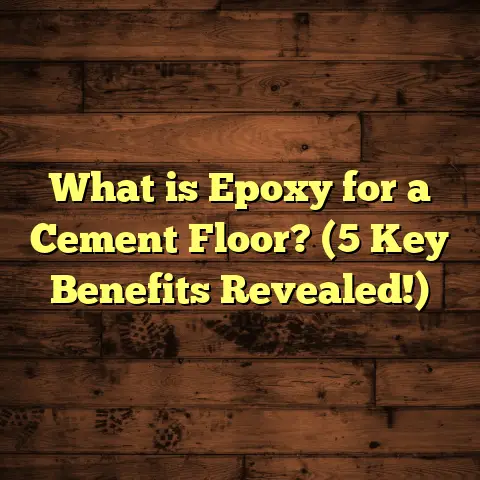What is Terracotta Floor Tiles? (5 Benefits for Your Home)
Sustainability has always been a guiding factor for me when it comes to home improvement choices. I believe the materials we bring into our living spaces should not only enhance the beauty of our homes but also respect our planet. That’s why I was drawn to terracotta floor tiles early in my flooring career. These tiles are a natural, eco-friendly option that have been used for centuries, yet they still fit perfectly with modern design sensibilities and sustainable living goals.
I want to share everything I’ve learned about terracotta floor tiles—their history, benefits, installation tips, and maintenance tricks—based on my own hands-on experience. I’ll also include data and case studies that helped me make informed decisions for myself and my clients. If you’re thinking about flooring options that combine durability, beauty, and a smaller environmental footprint, this might be just the article for you.
What Exactly Are Terracotta Floor Tiles?
Terracotta floor tiles come from a simple, natural place: clay mixed with water, shaped, and then baked or fired in kilns at relatively low temperatures compared to other tiles like porcelain. This firing process gives the tiles their signature warm reddish-brown color—although they can also range into yellows, oranges, and even deep browns depending on the clay composition and firing conditions.
The term “terracotta” means “baked earth” in Italian, which perfectly captures the essence of these tiles being an earthy product of nature. Unlike glazed ceramic or porcelain tiles, terracotta is typically left unglazed or only lightly glazed, preserving its porous surface. Because of this porosity, terracotta needs sealing to prevent water damage and stains.
A Brief History of Terracotta
Terracotta has been around for thousands of years. You can find ancient terracotta artifacts in civilizations from Mesopotamia to the Indus Valley. In flooring, Mediterranean countries like Italy and Spain have long used terracotta tiles in homes and public buildings.
When I first visited Tuscany years ago, I was struck by how well these old terracotta floors had stood the test of time despite centuries of use. The floors felt warm underfoot and added a rustic charm that modern materials often lack.
How Are Terracotta Tiles Made?
The process is deceptively simple yet requires artisanal skill:
- Clay Preparation: Natural clay is dug from quarries, cleaned of impurities, and mixed with water to form a malleable mass.
- Shaping: The clay is shaped either by hand or using molds into tiles of various sizes and shapes.
- Drying: Before firing, the tiles are air-dried slowly to prevent cracking.
- Firing: Tiles are kiln-fired at temperatures between 1000°F and 2000°F. Lower firing temperatures compared to porcelain preserve the porous texture.
- Finishing: Some tiles are left natural; others receive a light glaze or finishing coat to enhance durability or aesthetic appeal.
The artisanal nature means each tile varies slightly in color and texture—this uniqueness is part of their charm.
Five Key Benefits of Terracotta Floor Tiles for Your Home
1. Environmentally Friendly Material
One feature I can’t emphasize enough is terracotta’s sustainability. The raw materials are abundant—clay is naturally occurring and doesn’t require intensive processing like synthetic flooring materials.
I remember working with a client who was very environmentally conscious; she insisted on using only natural products in her home renovation. Terracotta tile fit perfectly because it’s biodegradable and requires minimal chemical treatments.
Unlike vinyl or laminate flooring, which use plastics and emit volatile organic compounds (VOCs), terracotta doesn’t release pollutants into your home atmosphere. This makes it especially appealing if you or your family suffer from allergies or asthma.
A 2022 report from the Green Building Council showed that homes using natural flooring materials like terracotta had a 30% improvement in indoor air quality compared to synthetic options.
Additionally, terracotta floors are extremely durable. When installed and maintained properly, they can last over 50 years—some historic buildings have terracotta floors older than 100 years still intact. This longevity means less waste over time because you won’t be tearing out floors every decade or so.
2. Warmth and Aesthetic Beauty
If you’re anything like me, you want your home to feel welcoming and warm. Terracotta tiles excel at this more than any cold ceramic or porcelain tile could.
Their earthy reds, oranges, and browns create a cozy atmosphere that complements rustic, Mediterranean, farmhouse, and even modern designs when paired thoughtfully.
Let me share a story: One project I worked on was a beach house where the clients wanted both durability and warmth underfoot. We chose terracotta for the kitchen and dining area, sealing it with a matte finish to keep things natural-looking but protected.
The homeowners told me later that guests kept commenting on how inviting the floor felt—it made everyone linger longer around the kitchen table, enjoying the homey vibe.
The natural variations in color from tile to tile mean no two floors look exactly the same. These subtle differences add character that mass-produced flooring just can’t replicate.
3. Great Thermal Mass Properties
Terracotta’s thermal qualities are impressive—and useful! The material naturally absorbs heat during the day and slowly releases it when temperatures drop at night. This helps regulate temperature inside your home without extra energy consumption.
I installed terracotta flooring with radiant heating in my own home’s kitchen. The tiles spread warmth evenly across the floor surface, reducing cold spots common with hardwood or laminate floors.
According to research published by the Building Research Establishment (BRE), homes with terracotta floors paired with radiant heat systems can reduce heating costs by up to 15%. That’s a noticeable energy saving over time—especially in cooler climates.
Even without radiant heat, terracotta floors stay cool during summer months because they don’t trap heat like carpet or wood might. This natural temperature regulation provides comfort year-round.
4. Durable Flooring That Ages Beautifully
Despite their delicate appearance, terracotta tiles are incredibly tough when sealed properly.
When installing these tiles, I always emphasize proper sealing because their porous nature means they can absorb moisture and stains if untreated. But once sealed, they resist wear from foot traffic remarkably well.
I recall restoring an old farmhouse where original terracotta floors had cracks and chips but were structurally sound after centuries of use. We carefully repaired damaged areas and resealed everything, extending the floor’s life for decades more.
Unlike carpet or vinyl that degrade quickly under heavy use, terracotta matures beautifully over time—developing a patina that adds richness rather than looking worn out.
5. Flexible Design Options
You might think terracotta is only for rustic or traditional homes—but that’s far from true.
There’s a wide variety of tile shapes—including squares, hexagons, octagons—and finishes ranging from matte to polished or lightly glazed surfaces.
This flexibility allows you to get creative with patterns like herringbone or checkerboard layouts or mix colors for a custom look.
In a recent job I handled for a client wanting something unique, we combined terracotta tiles with sleek contemporary furniture and neutral walls—the contrast created a striking blend of old and new styles that worked beautifully.
The ability to customize makes terracotta a versatile choice whether you’re renovating a historic property or designing a new build.
Installation Tips From My Experience
Preparing the Subfloor
Terracotta is heavy and brittle if not supported properly. One lesson I learned early on was never to skimp on subfloor preparation.
Make sure your subfloor is clean, level, and structurally sound before laying tiles. Uneven surfaces can cause cracks down the line.
Using cement backer boards or appropriate mortar beds ensures stability—especially important for high-traffic areas like kitchens or entryways.
Use Flexible Adhesives and Grout
Because terracotta expands and contracts with temperature changes more than ceramic or stone tiles do, flexible adhesives are essential.
Rigid adhesives risk cracking tiles as they move slightly with temperature fluctuations.
Grout should also be selected carefully—epoxy grout works well because it resists moisture penetration and is easy to clean.
Seal Immediately After Installation
Sealing right after installation protects your investment from stains during use.
I prefer using penetrating sealers because they soak into the tile rather than forming a surface film that can peel off over time.
If you want a shiny look without losing natural texture, combining penetrating sealers with a light top coat finish works great.
Consider Professional Installation
While DIY installation is possible for small areas if you’re handy, I highly recommend professional installers for larger projects or outdoor applications due to complexity involved in preparation and sealing stages.
A professional will ensure your floor lasts as long as possible without costly repairs down the road.
Maintenance Advice: Keeping Terracotta Beautiful
Regular Cleaning
Routine cleaning keeps your floor looking fresh without damaging it:
- Sweep or vacuum regularly to remove grit that can scratch surfaces.
- Mop with warm water mixed with mild soap—avoid acidic or abrasive cleaners.
- Dry floors promptly after mopping to prevent water absorption through any cracks in sealant.
Resealing Every Few Years
Depending on foot traffic and environment (like kitchens vs covered patios), resealing might be necessary every 2–5 years.
Neglecting resealing leads to staining or moisture damage which weakens tiles over time.
I always advise clients to schedule resealing as part of their annual home maintenance checklist—it’s quick but extends flooring life dramatically.
Dealing With Stains
Because terracotta is porous even when sealed, spills should be wiped immediately where possible.
For stubborn stains like oil or wine:
- Use baking soda mixed with water to gently lift marks.
- Avoid harsh chemicals—they may strip sealers or discolor tiles.
- Professional cleaning products designed specifically for natural stone work well too.
Real-Life Case Studies
Case Study: Historic Italian Villa Restoration
In one project involving an Italian villa more than 150 years old, original terracotta floors showed heavy wear but were structurally intact.
We carefully removed damaged sections and sourced matching local clay tiles handcrafted by artisans using traditional methods—the same way they were made centuries ago.
This approach preserved authenticity while reducing environmental impact by supporting local production rather than importing materials.
Post-restoration surveys confirmed the floors’ thermal comfort improved indoor temperatures noticeably during winter months without increasing heating use—a testament to terracotta’s natural insulation properties.
Case Study: Allergy-Sensitive Family Home Upgrade
A family suffering from multiple allergies switched from synthetic carpet floors to sealed terracotta in their living areas and bedrooms.
Within weeks of installation, family members reported fewer allergy symptoms such as sneezing and respiratory irritation.
They attributed this improvement partly to reduced VOCs released by synthetic flooring previously installed and better indoor air quality due to natural materials used throughout their home renovation.
This case highlights how thoughtful material choices can impact health as well as aesthetics.
Cost Breakdown: What To Expect Financially
You might wonder about affordability compared to other flooring options:
- Material Cost: Quality terracotta tiles range from $5 to $15 per square foot depending on finish, size, and origin (imported artisan tiles cost more).
- Installation: Professional installation adds $10 to $20 per square foot due to prep work and sealing requirements.
- Maintenance: Sealers cost roughly $50–$100 per gallon covering hundreds of square feet; resealing every few years is advisable.
- Longevity: With 50+ years lifespan potential, your long-term cost per year can be lower than cheaper materials needing frequent replacement like laminate or carpet.
Comparatively:
| Flooring Type | Initial Cost (per sq ft) | Lifespan (years) | Maintenance Cost | Approximate Yearly Cost |
|---|---|---|---|---|
| Terracotta Tile | $15 – $30 | 50 – 100 | Low (reseal) | $0.30 – $0.60 |
| Hardwood | $20 – $40 | 20 – 50 | Moderate (refinish) | $0.80 – $2 |
| Laminate | $5 – $10 | 10 – 20 | Low | $0.25 – $1 |
| Vinyl | $3 – $8 | 10 – 20 | Low | $0.15 – $0.80 |
This table gives you an idea of how investing upfront in quality materials like terracotta can pay off financially over time.
Design Ideas Using Terracotta Tiles
If you’re wondering how to incorporate these tiles into your home style:
- Rustic Farmhouse Look: Pair large square terracotta tiles with wooden beams and vintage furniture.
- Mediterranean Style: Use hexagonal patterns with warm grout lines; add wrought iron accents.
- Modern Eclectic: Mix terracotta with sleek concrete countertops or minimalist furniture for contrast.
- Outdoor Spaces: Use larger unglazed tiles on patios or sunrooms for a natural feel connected with your garden.
I once helped a client create an outdoor kitchen featuring terracotta flooring paired with stone countertops—the earthy tones blended beautifully with surrounding greenery creating a serene entertaining space.
Frequently Asked Questions
Q: Can terracotta tiles be used outdoors?
A: Yes! Unglazed terracotta works well outdoors but requires high-quality sealers resistant to weathering. In colder climates where freeze-thaw cycles occur frequently, additional measures like drainage layers can prevent cracking.
Q: How often do I need to reseal my floor?
A: Typically every 2–5 years depending on foot traffic and exposure to moisture. Kitchens usually need more frequent resealing than living rooms due to spills.
Q: Are terracotta floors slippery?
A: When sealed properly with matte finishes, they offer good slip resistance. Polished surfaces may be more slippery when wet—choose finishes based on area use.
Q: How do I clean stains?
A: Wipe spills immediately; for tough stains gently scrub with baking soda paste or special stone cleaners avoiding acids like vinegar which damage sealers.
If you’ve read this far, you’re probably starting to see why I’m such a fan of terracotta floor tiles—not just as a contractor but as someone who lives with them every day. They bring warmth underfoot, stand up to wear beautifully over decades, improve home comfort through thermal mass properties, support healthier indoor air quality, and contribute positively towards sustainability goals—all while looking stunningly natural and unique in any home style.
Have you ever walked barefoot on a cool clay tile on a hot summer day? That tactile connection with nature is hard to beat—and once you experience it at home, you might never want synthetic floors again.
Would you consider terracotta for your next flooring project? What concerns or questions do you have about working with natural materials? I’m happy to share more insights from my experience anytime!





